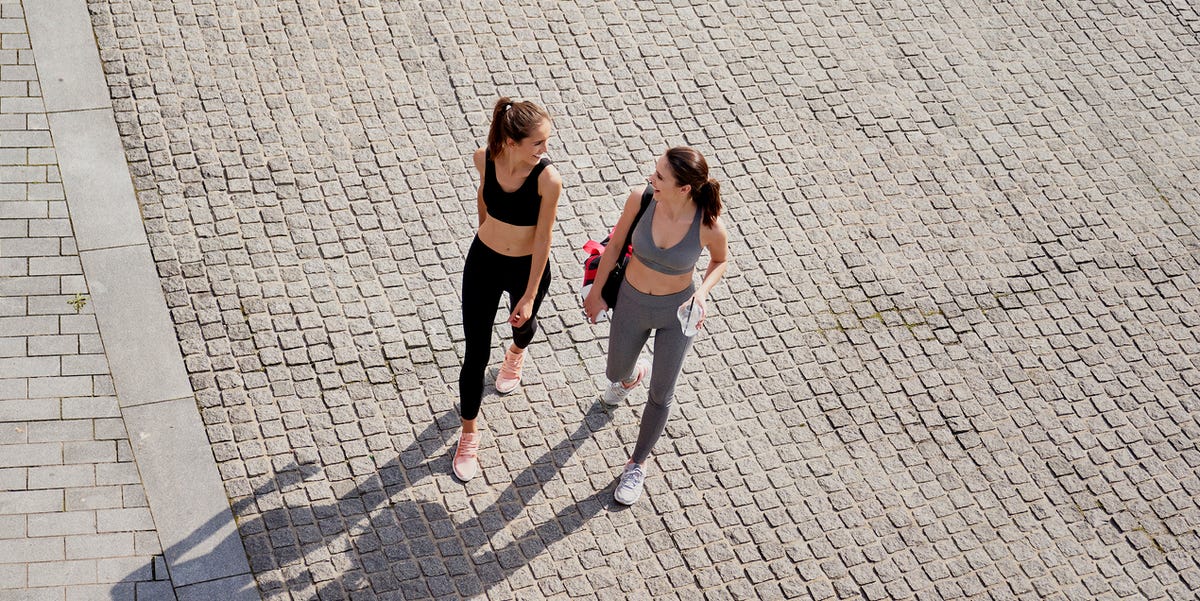Out are the days of only slogging through grueling high-intensity workouts like CrossFit and bootcamp classes day after day. Nowadays, chiller, low-impact activities, like walking, are having a moment, and for good reason. It doesn’t just feel good to get your steps in—walking also has legit health benefits and can complement any workout routine.
Walking has been found to increase aerobic fitness, decrease body fat, and reduce blood pressure in sedentary adults, according to a 2023 study in GeroScience. The review also found that people who live in Blue Zones, regions of the world where people tend to live the longest, do low-impact activities (like walking) on a regular basis.
Meet the experts: Grace Horan is a certified exercise physiologist at the Hospital for Special Surgery. Lindsey Bomgren, CPT, is a certified personal trainer and the founder of Nourish, Move, Love. Erica Coviello, CPT, is a certified personal trainer and the founder of Run, Fit, Stoked.
However, building muscle is also incredibly important when it comes to living and moving healthily for a long time. Ahead, find out whether walking on its own can build muscle, which muscles it works, and how to reap more strength benefits from your walking routine.
So, can walking actually build muscle?
While walking can help develop muscular endurance (a.k.a., your muscles’ ability to sustain exercise for long periods of time), it’s not the most effective way to build muscle, says Grace Horan, a certified exercise physiologist.
“To build muscle, the human body must be continuously challenged by increasing resistance and/or volume of exercise, which is known as progressive overload,” Horan says. Walking alone doesn’t provide enough resistance to induce muscle hypertrophy (an increase in muscle mass), which is better accomplished through resistance training, she says.
The reason walking on its own can’t stimulate muscle growth effectively? Walking activates your slow-twitch muscle fibers, which build muscular endurance and resistance to fatigue, as opposed to your fast-twitch muscles fibers, which build muscle mass, Horan explains. (FYI: Your fast-twitch muscle fibers can be activated through weight lifting, jumping, and sprinting.)
“You can increase the intensity of walks to engage more muscles by adding inclines or a weighted vest, but ultimately you need a greater external stress on the body—like resistance training—in order to build muscle,” adds certified personal trainer Lindsey Bomgren, CPT.
That said, older research suggests that aerobic exercise—like walking, running, or cycling—can build muscle in older adults and sedentary folks. In fact, regular exercise of any intensity, including walking, may help prevent age-related loss of muscle mass, per 2024 research in the International Journal of Behavioral Nutrition and Physical Activity. So, if you’re older or live a more sedentary lifestyle, walking may help build muscle mass—but your best bet is still to lift weights for gaining strength.
The Muscles You Work With Walking
Walking engages multiple muscle groups, says Bomgren. The primary muscles that work to propel you forward include the following, according to Horan:
- Quadriceps: A group of muscles located on the front of your thighs that work to extend your knees when you take a step forward
- Hamstrings: A group of muscles on the back of your thighs that are responsible for bending your knees and pulling your legs back as you walk
- Glutes (or butt muscles): Stabilize your pelvis and pull your leg away from your body when you swing your legs forward to take another step
- Calves: Muscles on the back of your lower legs that move your feet and push them off the ground, moving you forward
The secondary muscles walking strengths include your core and lower back muscles, which help hold you up and allow you to maintain good posture as you move, Horan says.
5 Tips For Building Muscle When Walking
You can add certain variables to your walking routine to put more of an emphasis on certain muscles, Bomgren says. Horan recommends walking for 30 minutes a day, five days a week at a moderate-intensity. (Moderate-intensity exercise should quicken your breathing, but not leave you breathless.)
And since walking is not the most effective modality for building muscle and overall strength, it’s important to do other types of activities that do build strength at least two days out of the week, like doing bodyweight exercises and lifting weights.
Try these tips to elevate your chances of building muscle while you walk, according to our experts:
1. Walk on an incline.
“Walking up a hill, on a hike for example, or a flight of stairs, will activate your glutes, hamstrings, hip flexors, and core muscles more than a flat surface,” Bomgren says.
If you’re not walking outside or don’t want to climb your stairs over and over, try the 12-3-30 treadmill workout (walking for 30 minutes at 3 mph and a 12 percent incline) or the 25-7-2 Stairmaster workout (using a stair climber for 25 minutes at level 7 two days a week) for an excellent burn.
2. Use props to increase the intensity.
Rucking—which is wearing weights while you walk, such as ankle or wrist weights or a weighted vest—”will increase the load while you’re walking, which can help strengthen your muscles,” says certified personal trainer Erica Coviello, CPT. Wearing a weighted vest will recruit more core muscles, and using poles to do Nordic walking will activate more upper-body muscles, Bomgren says.
When it comes to adding weight, start gradually. Opt for the lightest weights, especially if you’re new to resistance training, and work your way up to avoid injury. You’ll know you’re ready for heavier weights when the weights you’ve been using feel light and you’re not as fatigued after your walk.
3. Add strength-based exercises.
Because strength training builds more muscle than walking, stop every five to 10 minutes on your walk to bust out a few reps of moves like squats or lunges. If you’re walking outside, you can even use a park bench for pushups or triceps dips.
“Exercise snacks”—repeated short bouts of physical activity, like banging out a set of sit-ups while you’re waiting for your morning coffee to brew or stopping to do some squats during a walk—can benefit muscle growth, especially for folks who are largely sedentary, per 2024 research in Sports Medicine and Health Science.
4. Try some HIIT.
Incorporating interval training into your walks—which involves alternating between high-intensity efforts and periods of low-intensity recovery—can help you build more muscle than walking at a slow, steady pace would, says Bomgren. That’s because the faster you walk, the harder your muscles have to work.
You can start with a ratio of walking fast for one minute, followed by five minutes of walking slowly. As you get used to this cadence, you can increase the amount of time you walk fast for.
5. Try different terrains.
“Changing surfaces can help strengthen some muscles and connective tissues in your ankles and legs,” Coviello says. Try walking on the beach or on some wooded or unpaved trails to add variety to your walking routine and work the muscles harder than you would on your normal sidewalk.
While walking—especially on flat surfaces at a low intensity—likely isn’t enough to build muscle, you can play with variables like intensity, resistance, incline, and terrain to up your chances of seeing gains. Just don’t forget to add some resistance training for the best chances of increasing your muscle size and strength.
Danielle Zickl is a freelance writer who has 10 years of experience covering fitness, health, and nutrition. She’s a graduate of Ithaca College. You can find her work here on Women’s Health, and in many other publications including PS, SELF, Well+Good, Runner’s World, Outside RUN, Peloton, Men’s Fitness, and more.
Read the full article here




